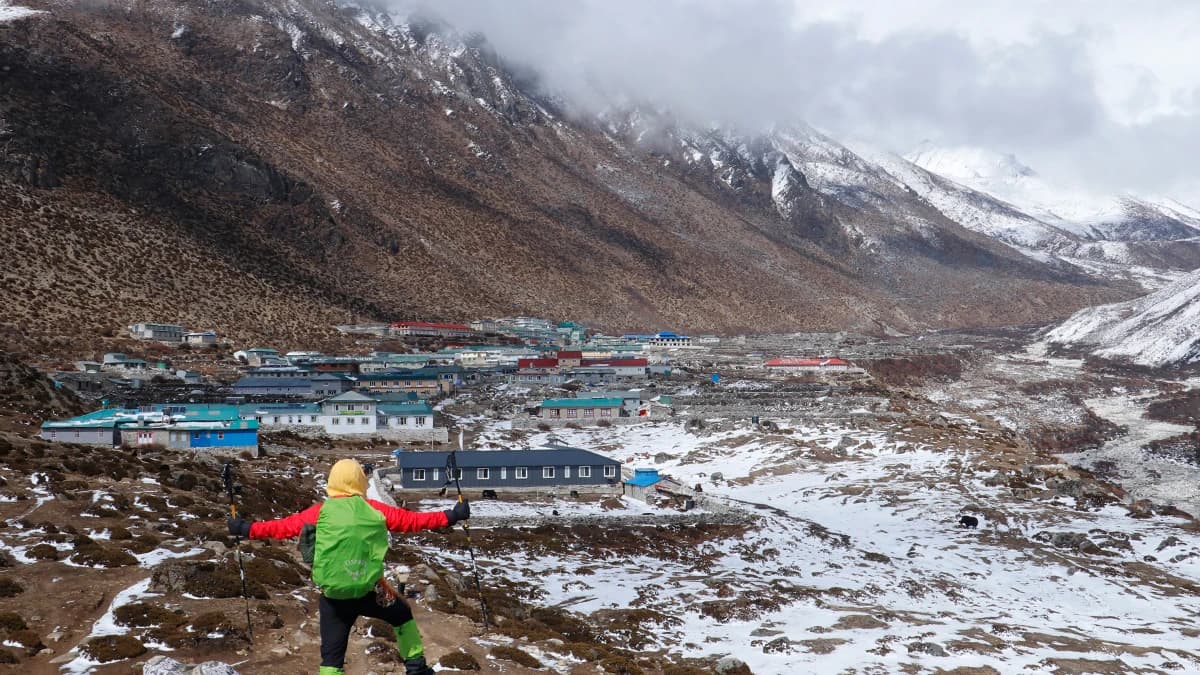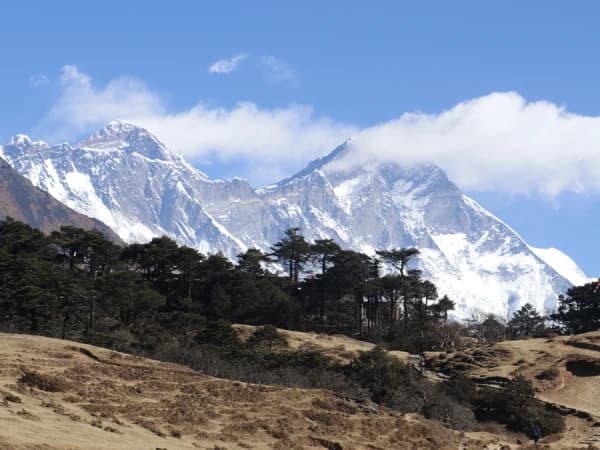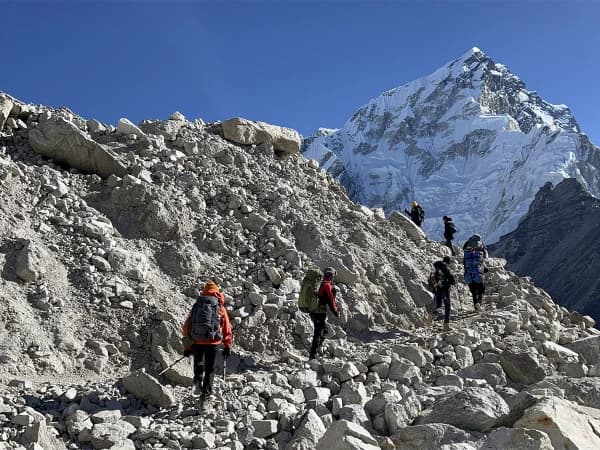The Everest Base Camp trek 12 days is an amazing journey that offers the experience of trekking to the everest base camp and Kalapatthar within the Everest region. This balanced Everest Base Camp Trek 12 days itinerary lets you enjoy the thrilling journey, immerse yourself in the rich Sherpa culture, and acclimatize in the serene environment.
Highlights of the 2026 Trek
- Thrilling 40-minute flight from Kathmandu to the world's most dangerous airport, lukla.
- Exploration of traditional Sherpa villages, interaction with local communities, and learning about their unique customs and lifestyles.
- Spectacular views of iconic peaks, including Mount Everest, Lhotse, ama dablam, and many others.
- Visit the Tengboche monastery, experience the serene environment, and learn about the spirituality.
- Acclimatization days in namche bazaar and dingboche, along with other small hikes and rests.
- Reaching the highest glacier on earth, khumbu glacier.
- Ascend to the altitude level of up to 5555 m, Kala Patthar, to see mountain views.
- Trekking through the diverse ecosystems within Sagarmatha National Park.
- Chance to encounter wildlife like musk deer and colorful pheasants.
- Crossing high-altitude suspension bridges adorned with colorful prayer flags and traversing lush forests.
A Brief Overview of the 2026 Trek
The Everest Base Camp trek 12 days begins with a scenic flight from Kathmandu to Lukla. From lukla, the actual trekking journey will start. You will trek to the Everest base camp and hike to Kala Patthar, passing through notable destinations like Phakding, Namche Bazaar, Tengboche, Dingopche, and Gorakshep.
During this journey, you will get to see the stunning views of the snowcapped peaks like mount everest, Lhotse, Nuptse, Ama Dablam, Makalu, Thamserku, Cho Oyu, and so on. As you approach near the Everest base camp, you'll witness the impressive Khumbu Glacier and the treacherous Khumbu Icefall.
Your short Everest Base Camp guided trek will be in the Sagarmatha National Park, an unesco world heritage site in nepal. The park surrounds diverse ecosystems, including lush forests, alpine meadows, and glacial landscapes. If you get lucky, you will get to see the rare species like snow leopards and red pandas.
The memorable part of the Everest base camp trek 12 days itinerary is cultural immersion in the traditional Sherpa villages. On the way, you will encounter the various Sherpa villages. During the visits, you will get to interact with sherpas, learn their culture and traditions, taste the authentic Sherpas cuisine, and relax at night.
If you want to learn more about the trek, here is the list of faqs.
Major Highlights of the 2026 trek
- Phakding (2,610 meters)
Phakding is a small village in the Khumbu region of Nepal. The village is nestled along the banks of the Dudhkoshi River. It gives you a glimpse of Tibetan Buddhism. Besides it, the local architecture is something that you should explore along with lush green hills, terraced fields, and towering mountains.
- Tengboche Village (3,867 meters)
Tengboche is a village in the Khumbu region, popular as home to the largest Gompa, Tengboche Monastery. Various festivals, like the Mani Rimdu Festival and the Dumje Festival, are celebrated there. It is also surrounded by lush green vegetation and beautiful scenery of the peaks, like Ama Dablam and Mount Everest.
- Everest Base Camp (5,364 meters)
The Everest Base Camp, also known as the South Base Camp, is located in the upper Khumbu region of Nepal. It is one of the main destinations of the 12-day Mount Everest Base Camp Trek. It is accessible from Lukla airport. From the camp, you can see the spectacular views of the iconic peaks like Mount Everest, Lhotse, and Ama Dablam.
- Kala Patthar Viewpoint (5,555 meters)
Kala Patthar is the iconic viewpoint that you will visit during the Everest Base Camp 12-day trek. From the viewpoint, you can see one of the closest panoramic views of Mount Everest, Lhotse, Nuptse, and the Khumbu Glacier. It is also home to one of the highest webcams in the world.
Why is Kala Patthar listed as a must-go place for a 12-day trek to Everest?
Kala Patthar is listed as a must-go place on this short trip because the world’s tallest peak, Mount Everest, is visible. The panoramic view of Mt. Everest with the Nuptse, Changtse, Lhotse summit, and northern flank adds to the beauty of your trek.
Is the 12-day trek itinerary to the EBC customizable for 2026?
Yes, the 12-day trek itinerary to the EBC is customizable. We can add extra hikes, excursions, and accommodation modifications with fixed trekking tracks and goals. The pre-arranged arrival and departure flight from Lukla cannot be modified on short notice; you have to stick with the determined flight arrangement. We have another trekking package to the Everest Base Camp; make sure to click here.
How do you feel while trekking at Everest Base Camp for 12 days?
The 12-day trek to Everest consists of varied feelings. Each day, you have to walk for more than 6 hours to complete the trek in time. The rugged terrain, rocky and unsteady path, adverse climatic conditions, and some natural obstacles make your trek very challenging.
After dealing with these challenges, a glimpse of the spectacular mountain, wildlife, and rare vegetation on the way surely makes you feel goosebumps. The tiredness from the day walk will be completely gone when you receive the warm hospitality of the locals while learning about their culture and traditions.
Why us for the 2026 Everest Base Camp Trek 12 Days?
3S: Safety, Success, and Satisfaction
Booking an Everest Base Camp trek 12 days package 2026 with Mystic Adventure Holidays offers superior service and benefits. Here's why:
- Client Safety: Our trips are organized with the utmost safety in mind.
- Best Price Guarantee: Ensuring you get the best value.
- Free Transfers: Complimentary airport-to-hotel and return transfers in a private vehicle.
- Expert Guides: Trained, government-licensed local guides with extensive route knowledge.
- Support for Locals: Helping local communities earn a living through tourism.
- Health Monitoring: Oximeters to monitor oxygen levels during high-altitude EBC treks.
- Medical Preparedness: Guides equipped with medical kits to handle any situations that may arise.
- Essential Gear: Arrangements for sleeping bags and down jackets.
- Free Storage: Secure storage at our office for extra luggage during your tour.
- Convenience: Duffel bags for transferring items to be carried during the journey.
- Porter Service: A free porter to help carry your heavy bags.

















